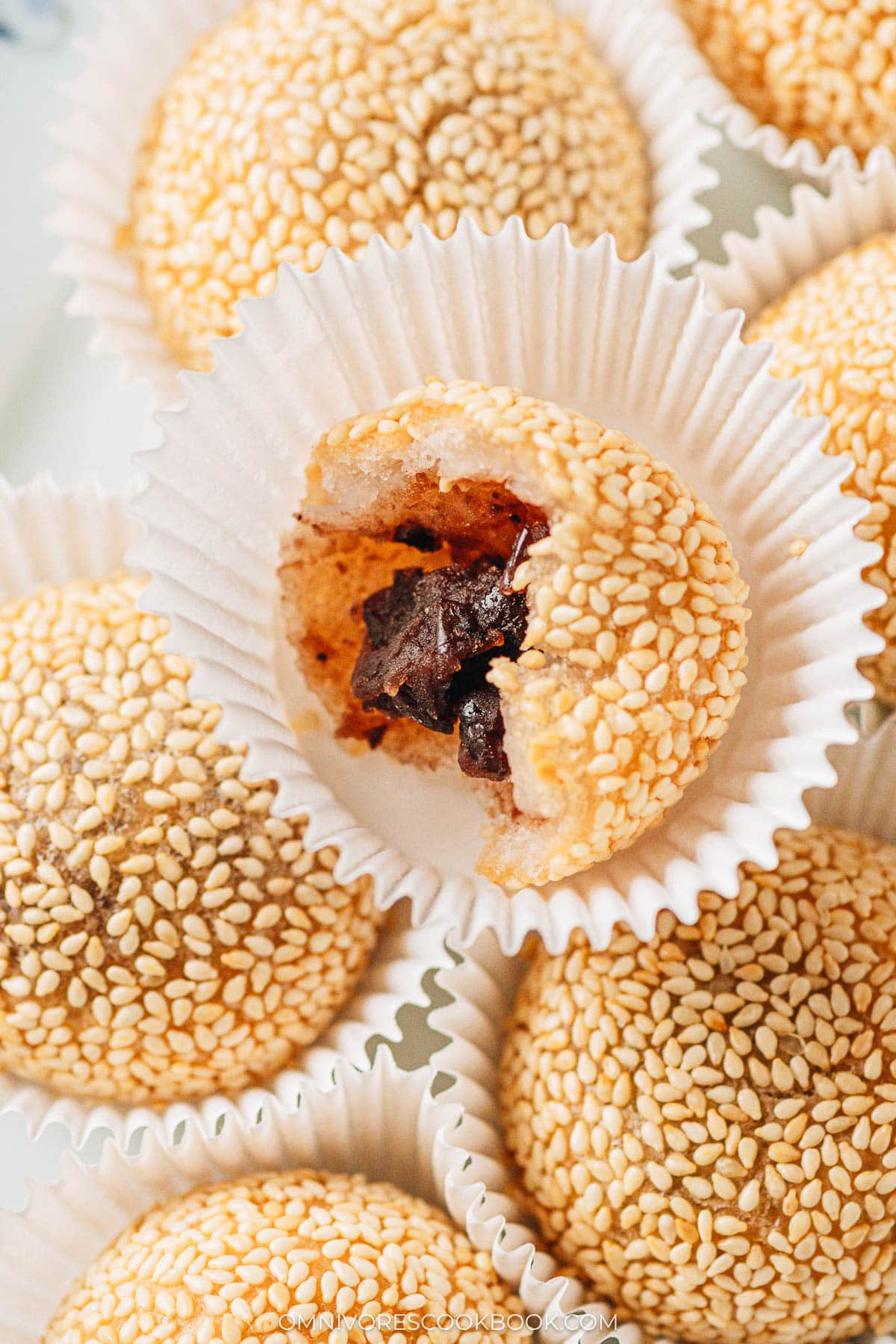
If you’ve ever visited a Chinese bakery or dim sum restaurant, you’ve likely encountered these golden, sesame-coated delights called Jian Dui (煎堆), Ma Tuan (麻团) or Chinese sesame balls. These iconic treats are not only visually appealing but also a delicious blend of textures and flavors that have been cherished for generations.
Sesame balls aren’t just a treat—they’re a cultural symbol. Their roundness and golden color signify good fortune, making them a must-have for celebrations such as Chinese New Year. Beyond their cultural importance, they’re beloved for their balance of sweetness, crispiness, and chewiness—a trifecta of satisfaction.
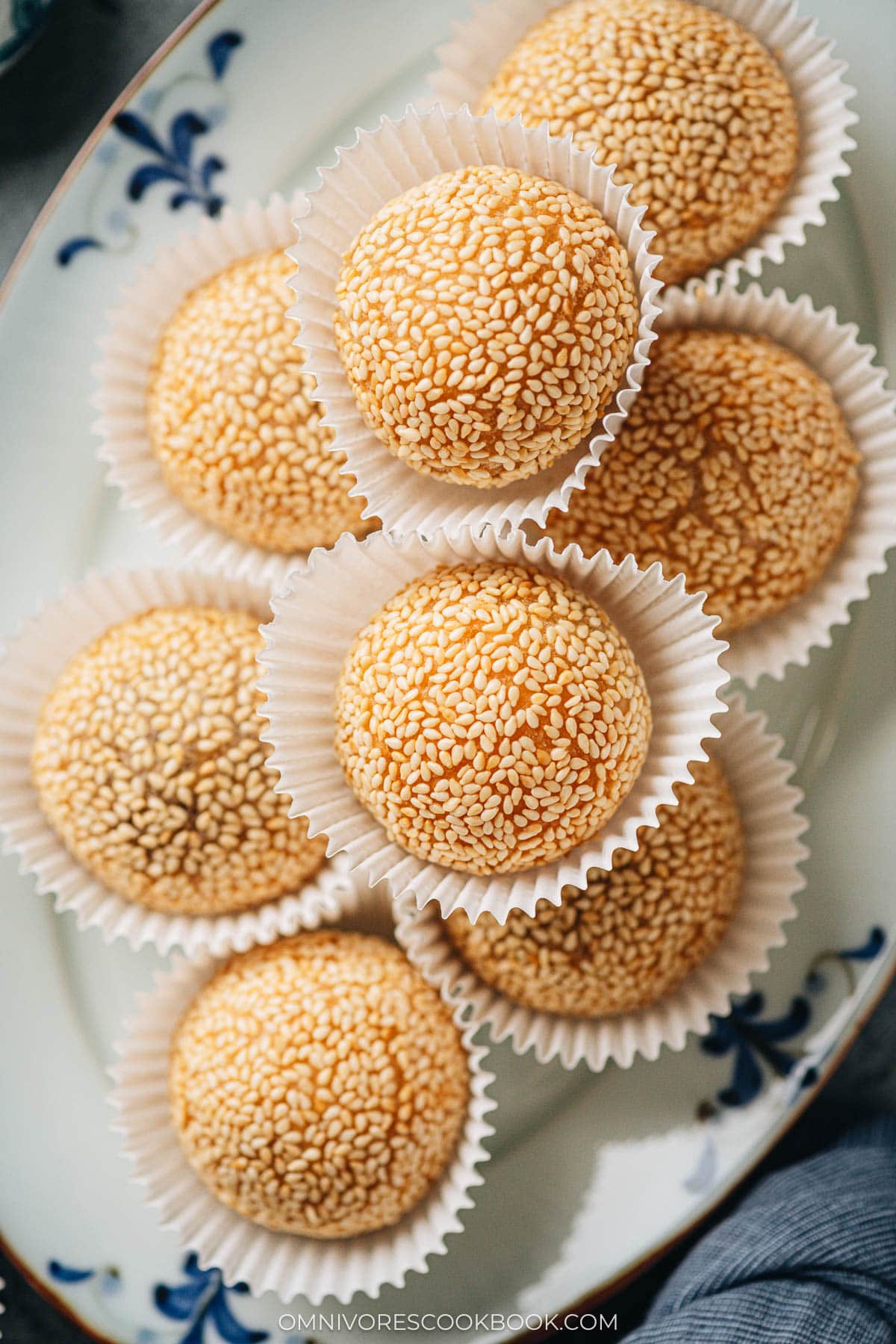
What Are Chinese Sesame Balls?
Chinese sesame balls are a deep-fried dessert made from glutinous rice flour, or sticky rice flour. It has a mochi-like gooey and sticky texture inside. It is often filled with a sweet filling such as red bean paste, lotus seed paste, or black sesame paste. The outside of the ball is coated in sesame seeds and deep fried until golden. The result is a beautifully puffed ball with a crispy exterior, a chewy shell, and a soft, sweet filling. They’re a staple in Chinese cuisine, especially during festive occasions like Chinese New Year, as their round shape symbolizes wholeness and the golden hue represents prosperity.
Chinese sesame balls take some time and effort to make at home. But the good news is, you can make them ahead of time and reheat them any time. This is especially convenient when you need to prepare several courses for your guests.
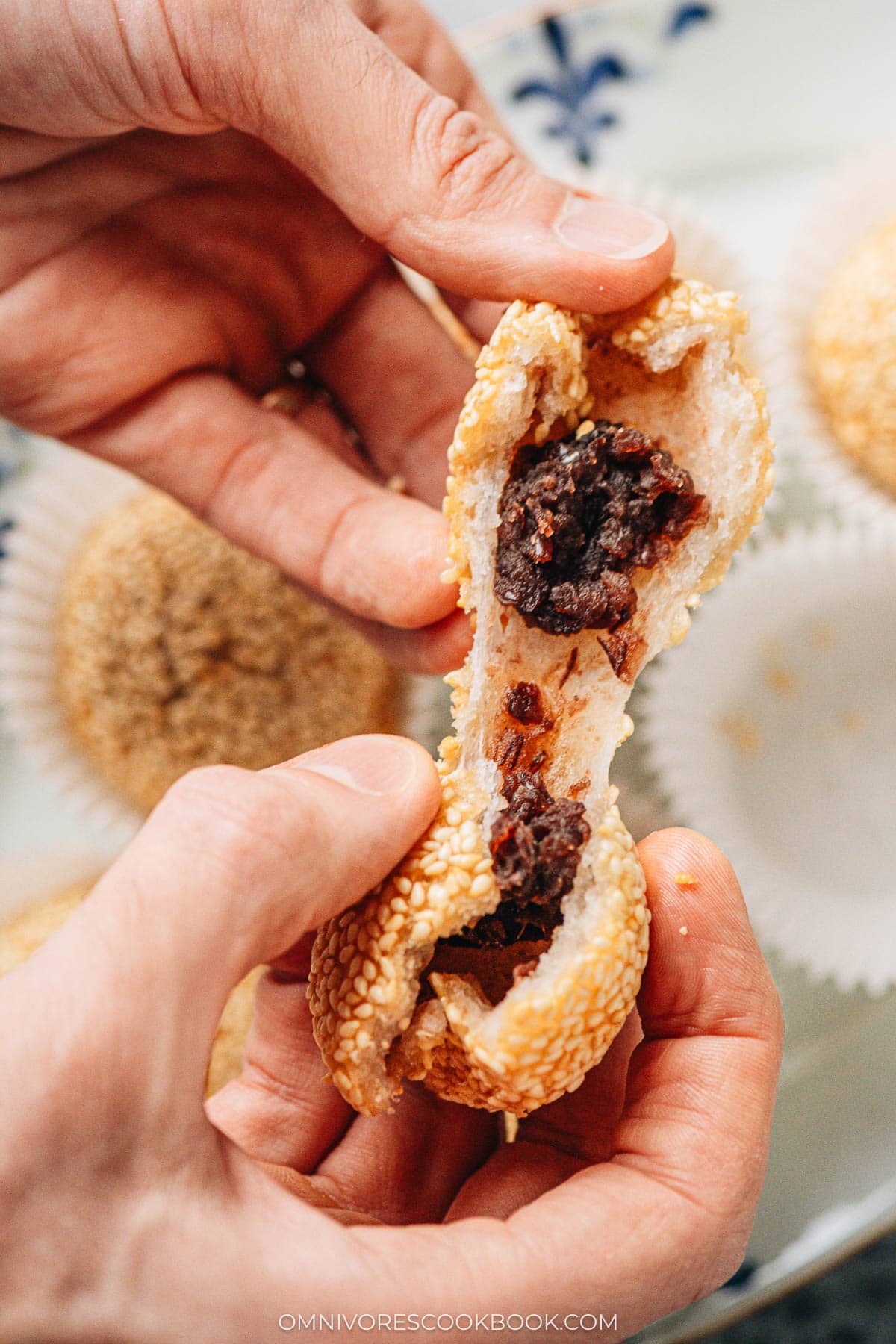
Ingredients you need
You only need five ingredients to make fried sesame balls. Some of them require a run to the Asian market, but these days you can probably get all of them online.
Glutinous rice flour
Glutinous rice flour, or sweet rice flour, is actually gluten free. This flour is very too easy to work with, almost like working with clay. And the dough yields a sticky texture once cooked.
I like to use the Erawan brand glutinous rice flour, which is very similar to the kind we use in China. I usually avoid Japanese brands (usually labeled as mochiko) because they usually use short grain glutinous rice. It absorbs water differently so it might throw off your flour-water ratio.
You can find glutinous rice flour at most Asian markets and on Amazon.
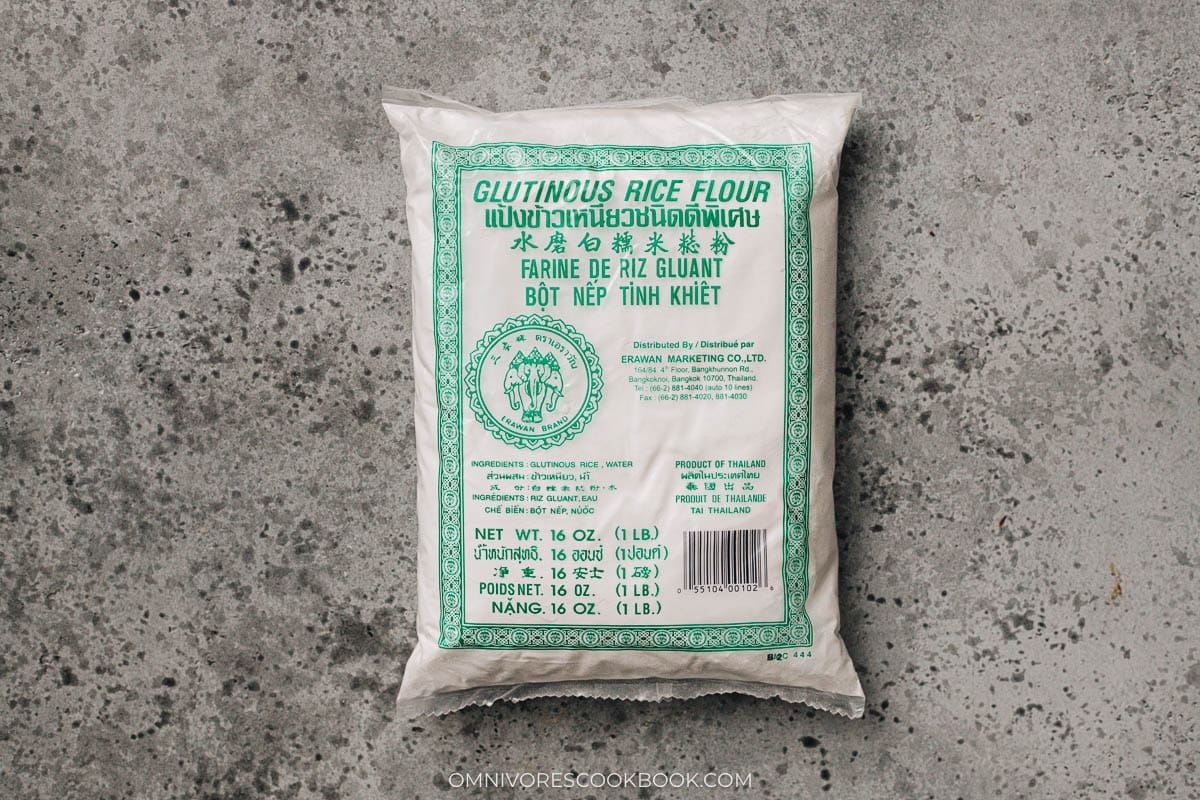
Sweet filling
My sesame balls recipe uses store-bought red bean paste. Either the fine paste or the chunky type works, but the fine bean paste is easier to work with. Make sure the main ingredients only contain red bean, sugar and water. Some Chinese brands of red bean paste contain maltose. That type is designed for making mooncakes and is very sticky. It’s best to avoid it.
I also love sesame balls filled with lotus seed paste. I have a recipe here if you’re interested in making your own.
You can find red bean paste in most large Asian markets, Chinese grocery stores, Japanese grocery stores, and on Amazon.
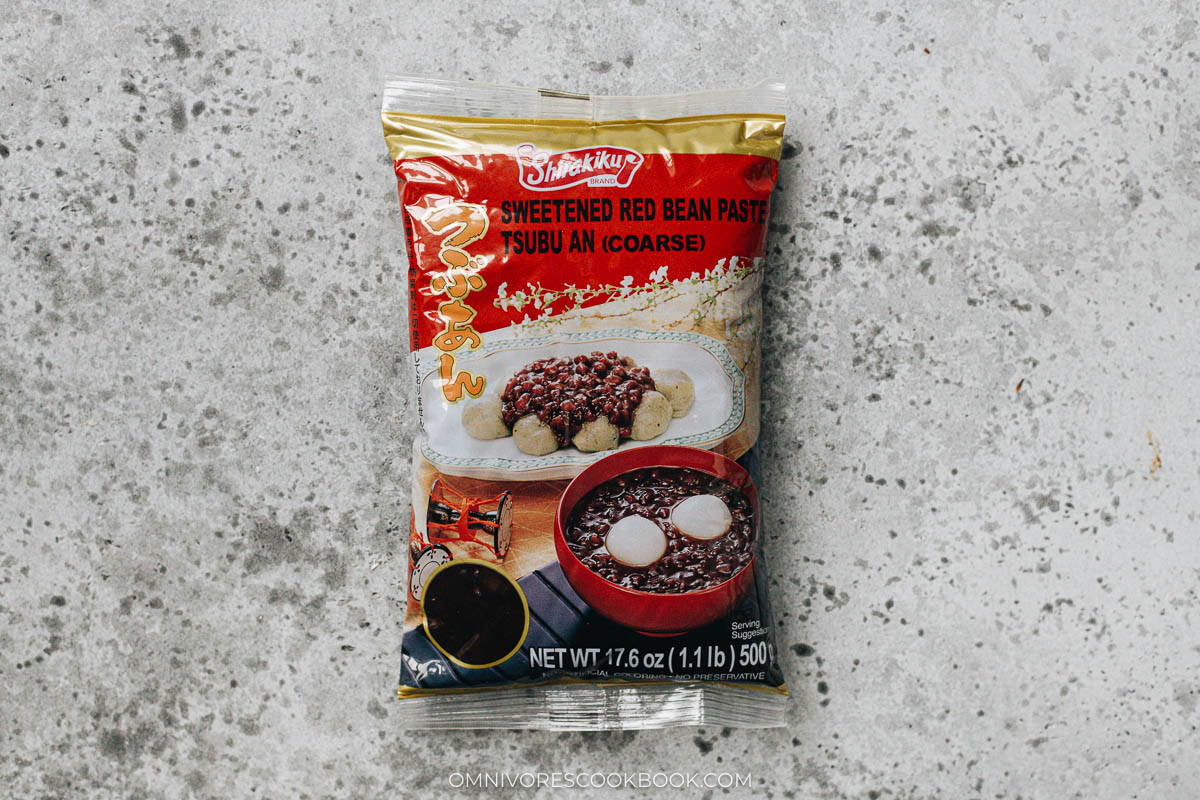
Sesame seeds
Any kind of sesame seeds work here, but I highly recommend using either raw sesame seeds or roasted and hulled sesame seeds. Raw white sesame seeds have a pale color that’s close to white. The roasted and hulled white sesame seeds have a pale yellow color. Both will look good once deep fried. The pre-roasted sesame seeds will look too dark once fried.
You can also use a very small amount of black sesame seeds in the blend for appearance. Sometimes dim sum restaurants use black sesame seeds to mark a different filling.
Frying oil
This recipe requires proper deep frying. Make sure you have enough frying oil (8 cups). I always prefer to buy a small bottle of oil just for frying. So I can store or dispose of the leftover oil in its own bottle after the oil has cooled off when I’m done frying.
Proper pot for frying
A medium-sized pot or small dutch oven is the best for deep frying because it has a high wall to prevent splatter, and it doesn’t require too much oil for deep frying.
If you like deep frying food at home, I highly recommend this small tempura pot (7.9”). It has a smaller diameter on the bottom so it requires less oil. It also comes with a thermometer and a cooling rack. It’s been a total game changer and I now enjoy deep frying more.
How to make sesame balls
To make sesame balls, I highly recommend using a scale to measure the ingredients instead of using cups. Especially when it comes to assembling the sesame balls. A precise measurement can guarantee that you use the correct dough to filling ratio, so the filling is properly sealed without using too much or too little dough.
Prepare the dough
To make the dough, boil the water with the sugar and salt to make a syrup. Then portion out 140g (3/4 cup) of glutinous rice flour, slowly pour the hot syrup into the dough, and mix.
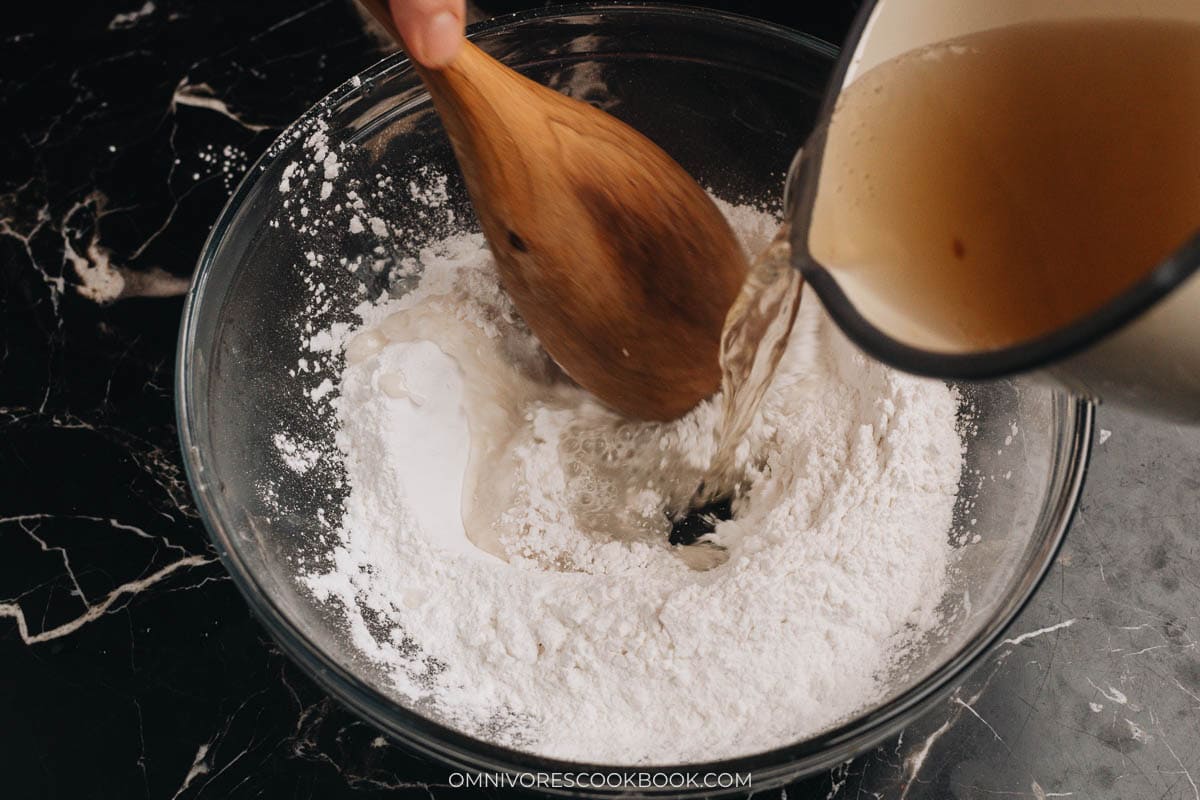
You will get a smooth paste without any lumps after a thorough mixing.
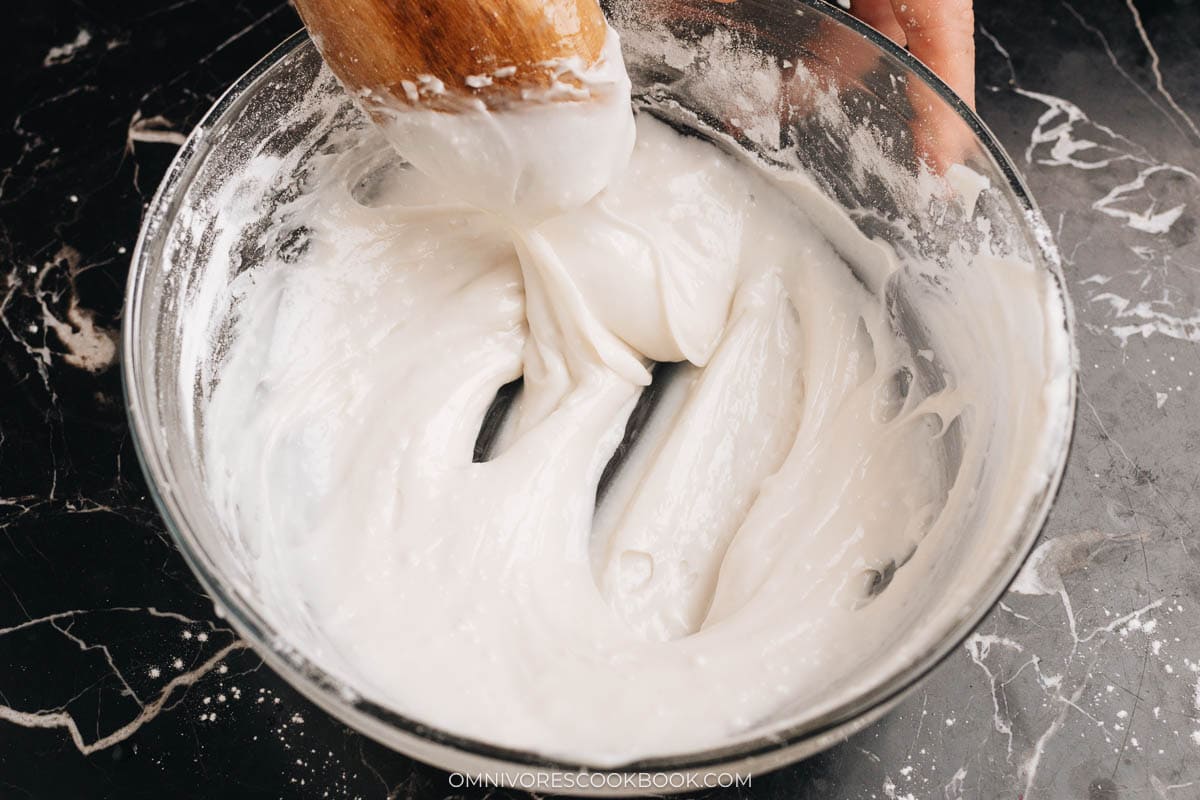
Then slowly add another 50g (1/4 cup) glutinous rice flour and mix.
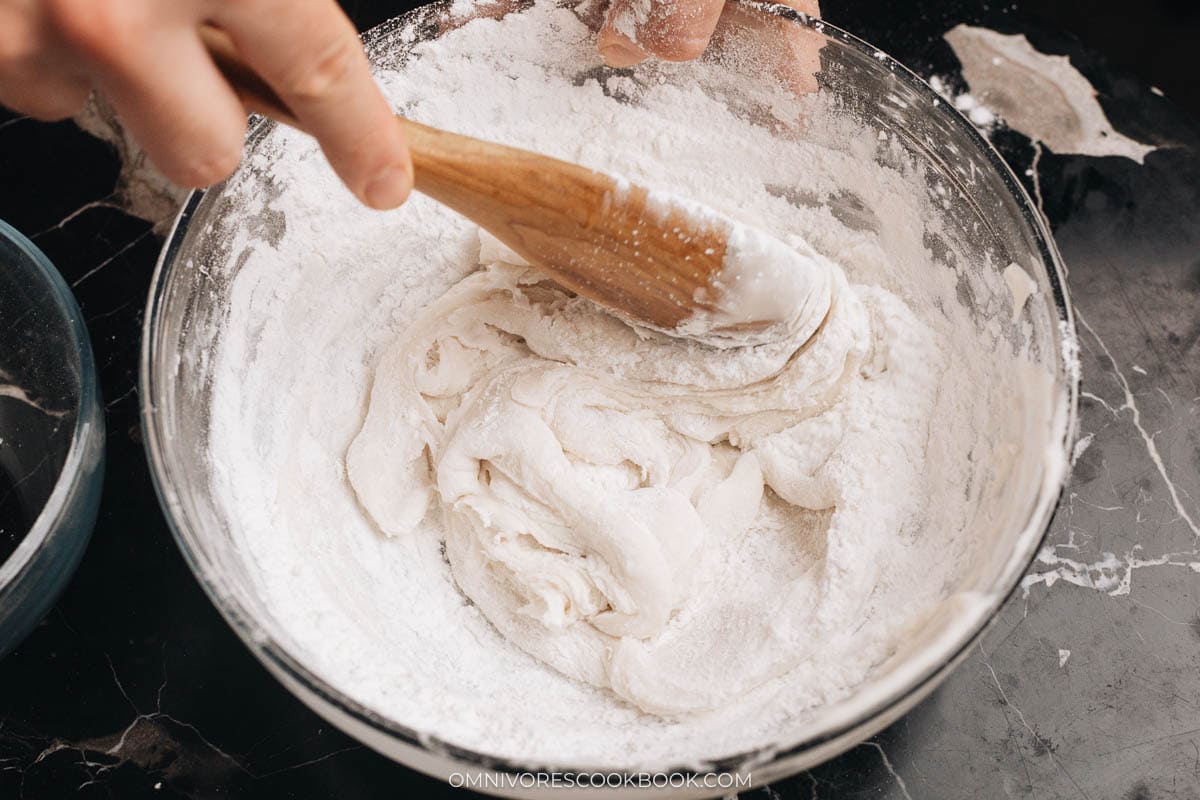
Once the flour is added, add 1 teaspoon of oil and knead the dough until smooth.
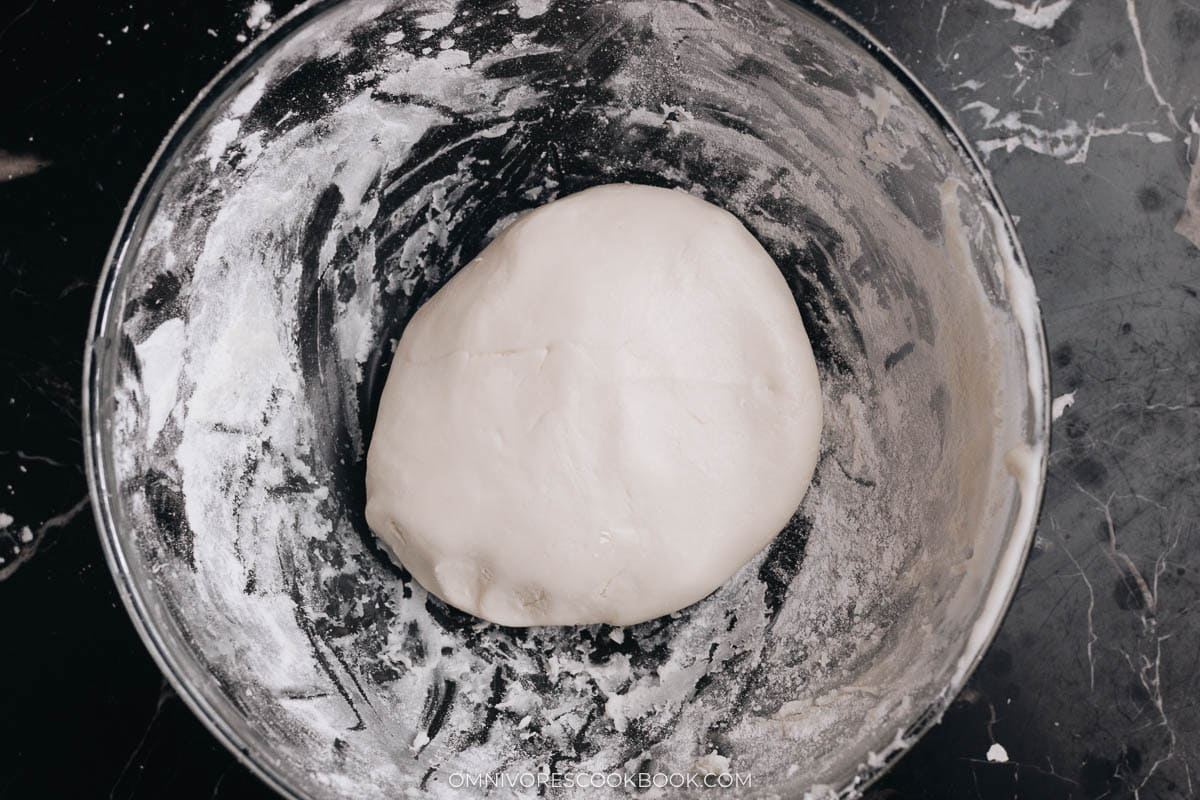
Then you will cover the dough and let it rest in the fridge for 30 minutes.
Prepare the filling
When the dough is resting, portion out the filling and shape it into small balls. I like to freeze these red bean paste balls in the freezer until they firm up. It makes the wrapping much easier when the red bean paste isn’t sticking to your hands.
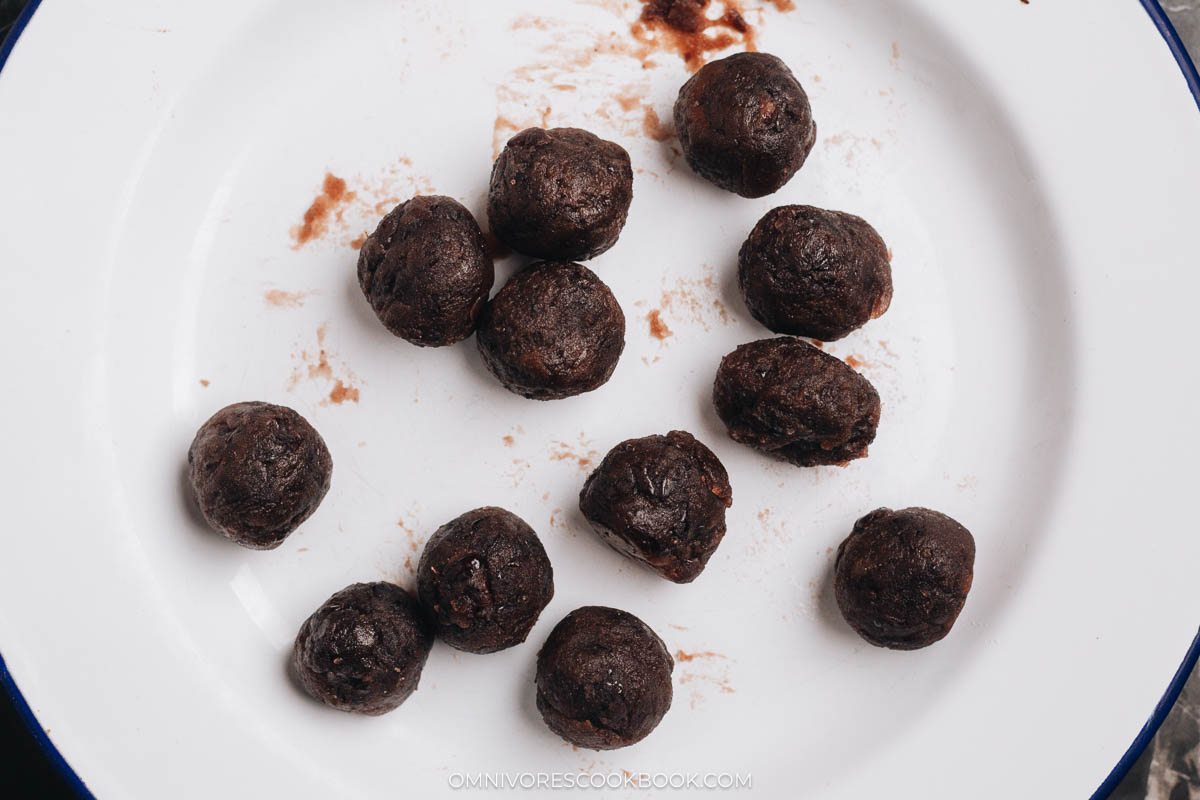
Assemble the sesame balls
Once the dough is rested, roll it into a long log.
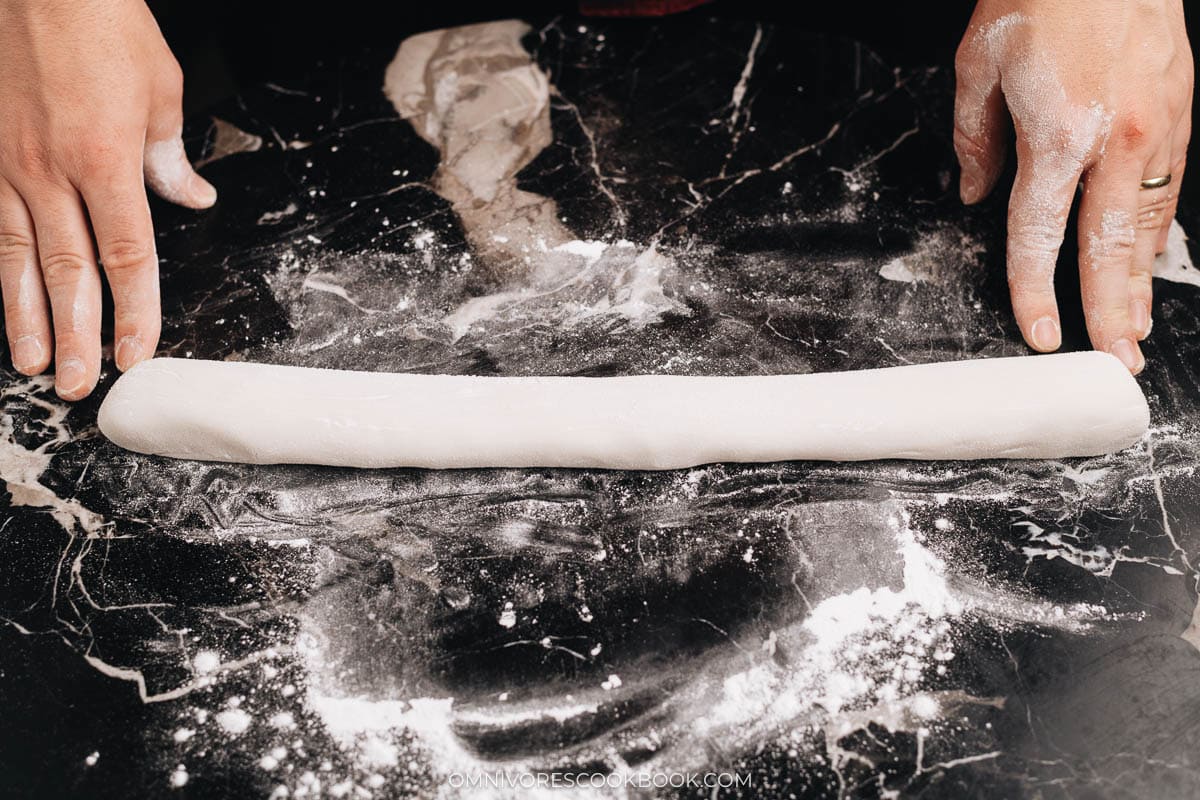
Then divide the dough into 12 equal portions. I like to cut the dough, then use a scale to even out the dough pieces so they are equally weighted.
TIP
I made 12 medium-sized sesame balls that are similar to the ones you’d get at a dim sum restaurant, but smaller than the large sesame balls from a Chinese bakery. If you prefer different sizes, feel free to change it up. You can make 8 bigger sesame balls for example. In this case, make sure you weigh the dough first then divide by 8. You also need to calculate how much red bean paste to use in each sesame ball (25 g if making 8).
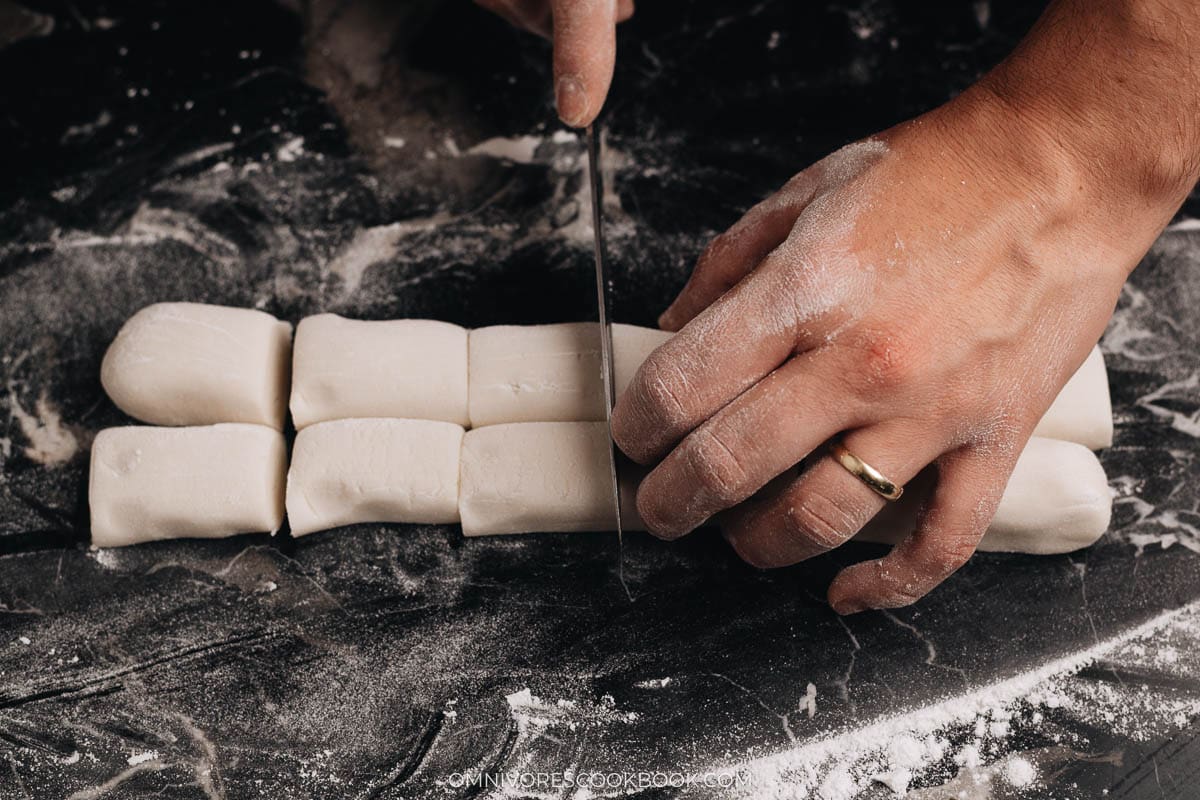
Once the dough is cut and weighed, roll it into balls. I always keep the unused dough and formed sesame balls covered with a wet towel, to prevent them from drying out.
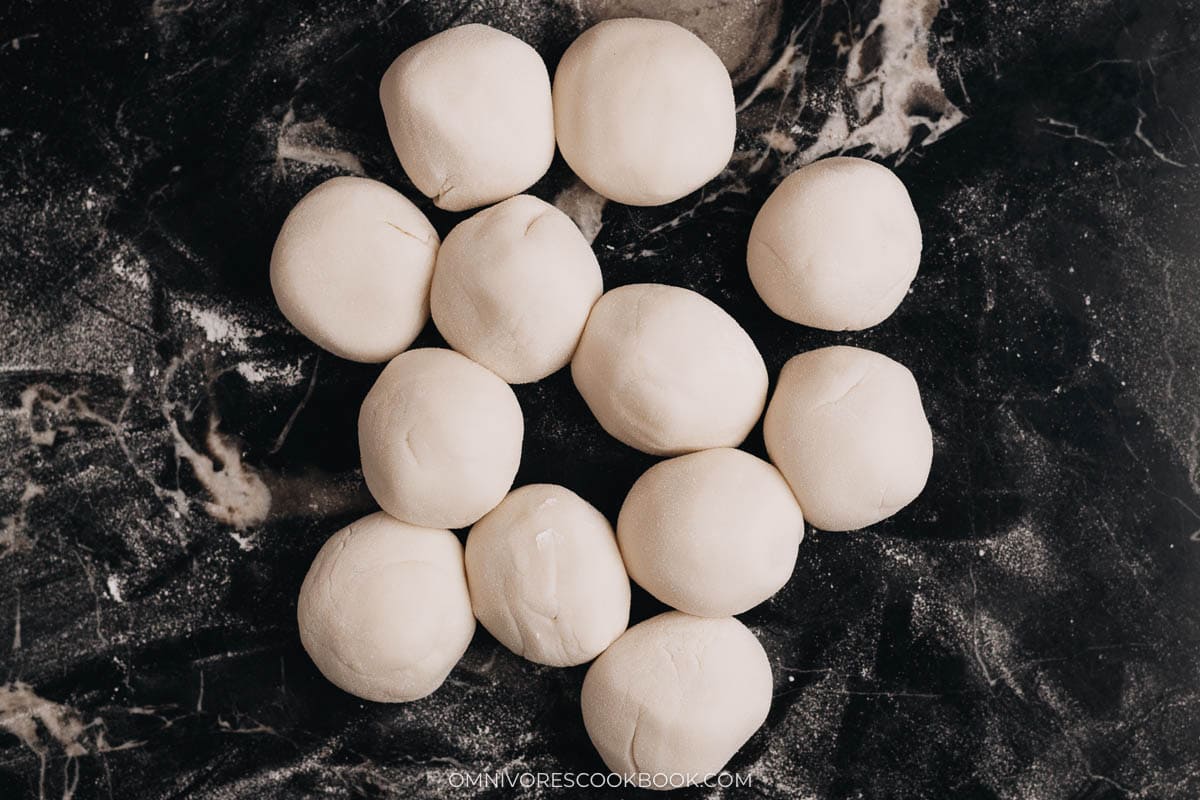
To assemble the sesame balls, use your finger to flatten the dough ball. The dough will feel like soft clay and be easy to work with. Place the red bean filling in the center.
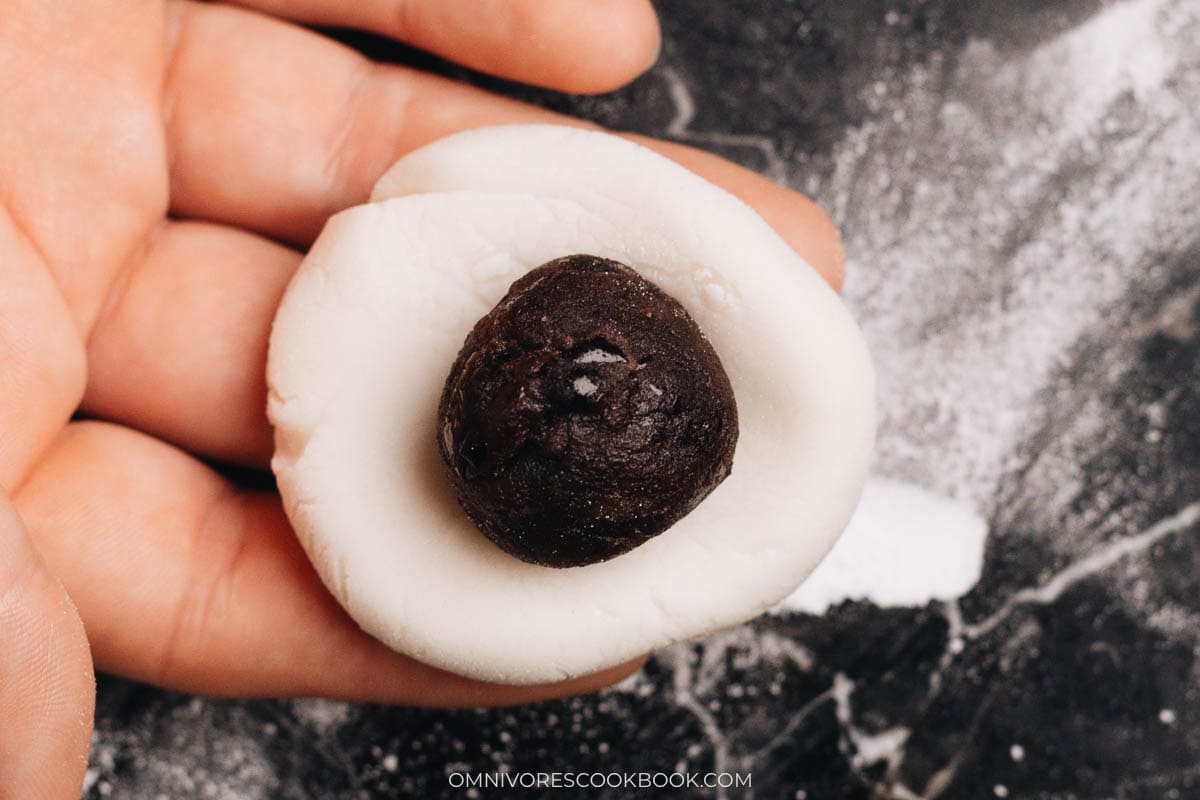
Then slowly push down the red bean paste while tucking the dough to the top, to seal the filling.
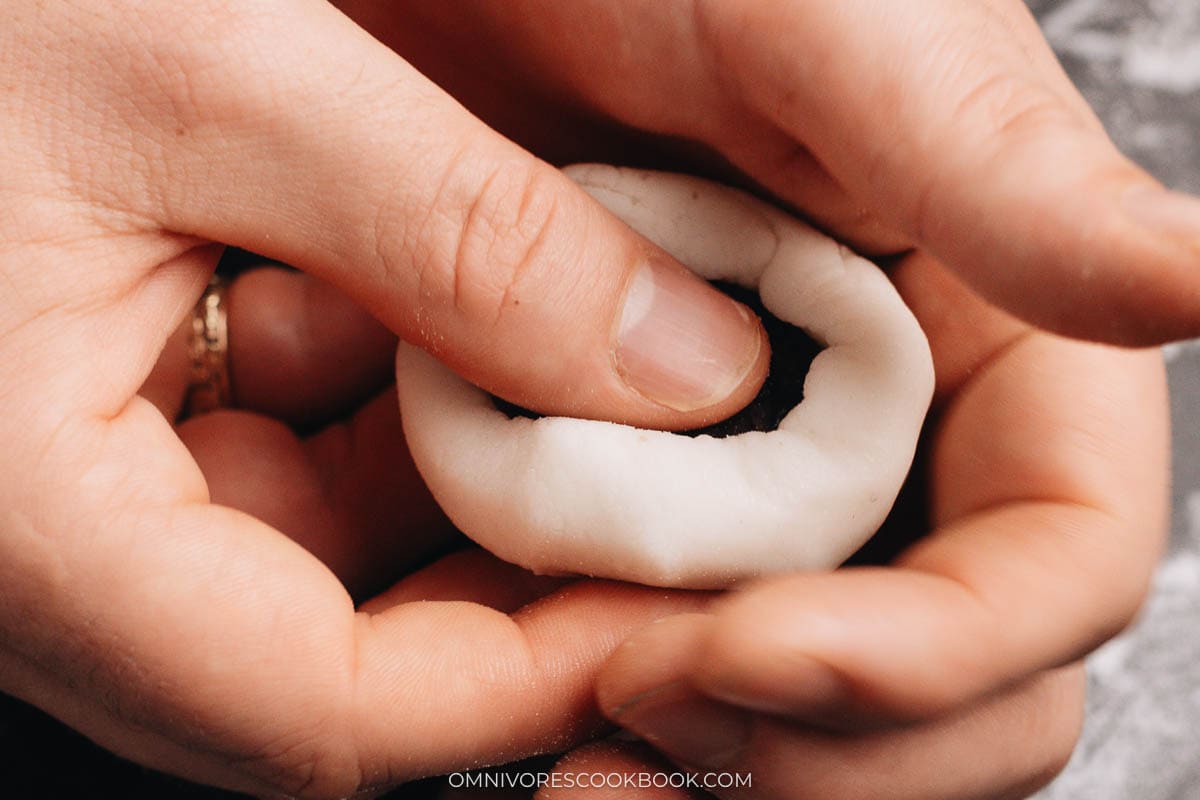
Make sure to close and pinch the dough together to seal the filling in completely. This is very important to keep the sesame balls intact through the frying process.
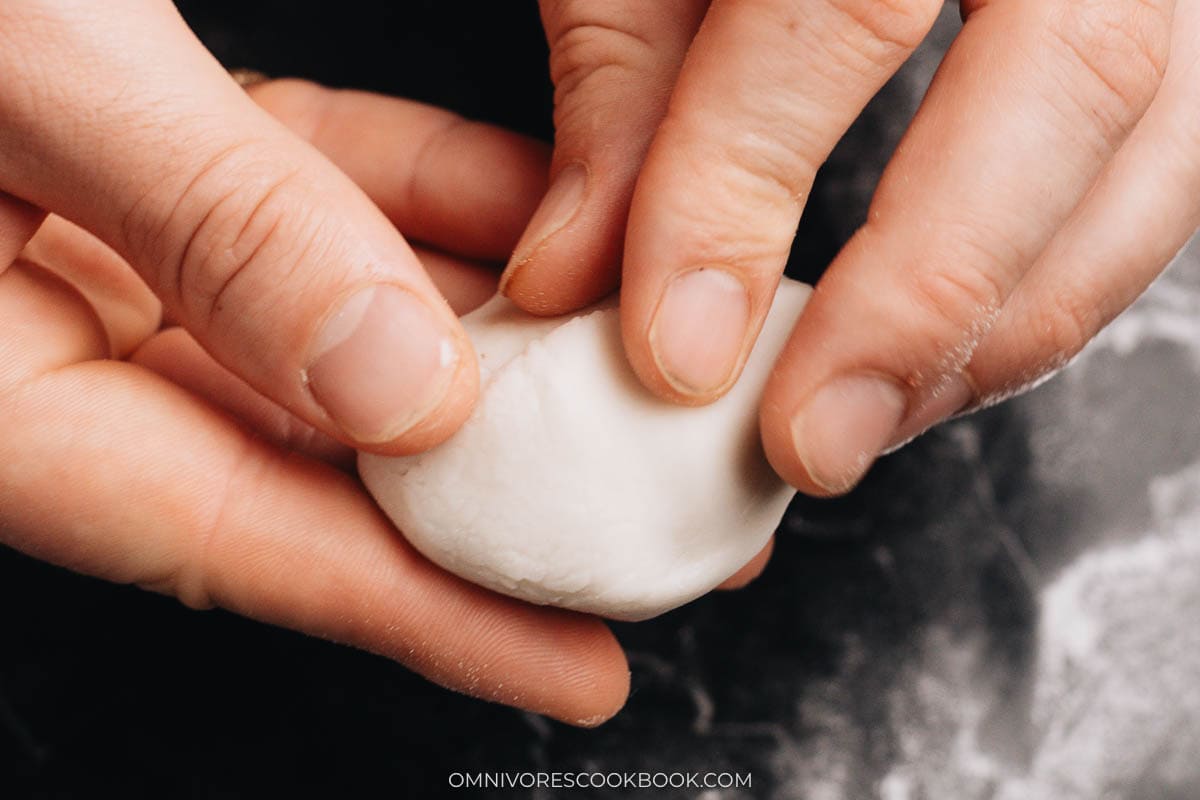
Then round out the ball again using your hands.
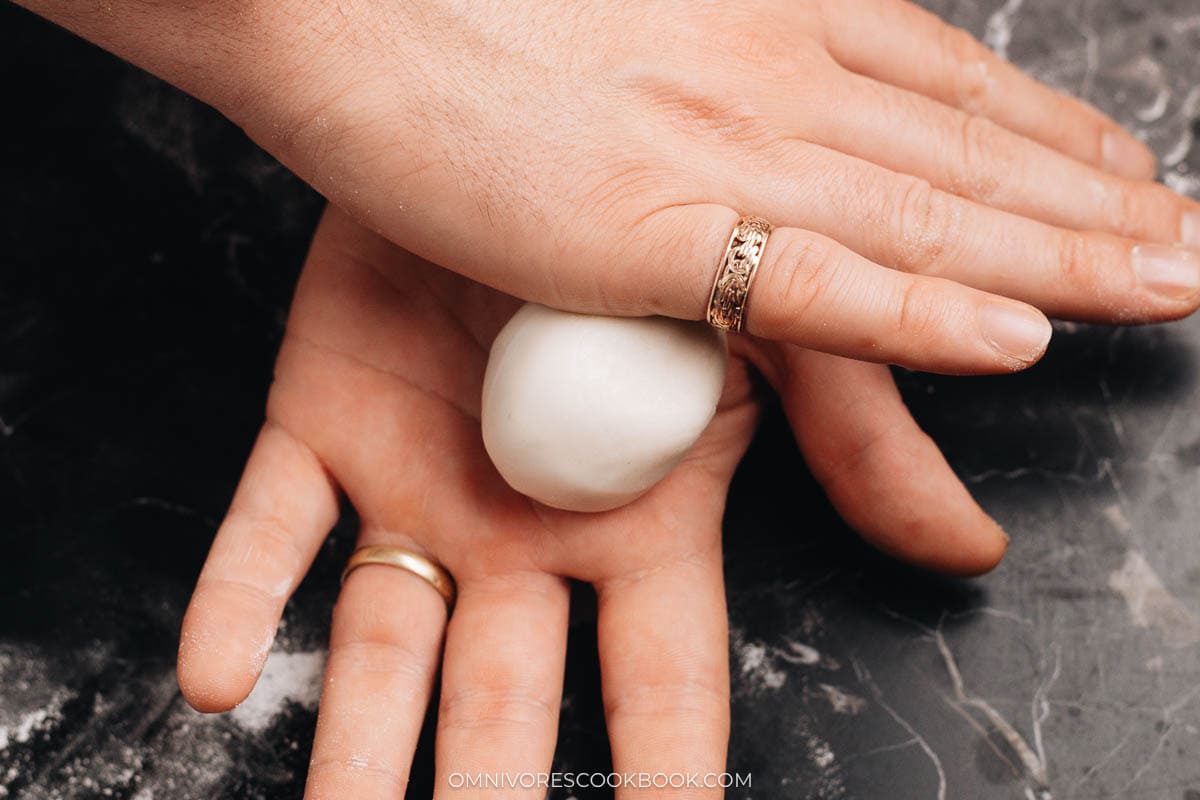
To coat the assembled dough balls with sesame seeds, wet your hands, then roll the dough in your palm so the dough is wet. The sesame seeds will only stick to a wet dough ball.
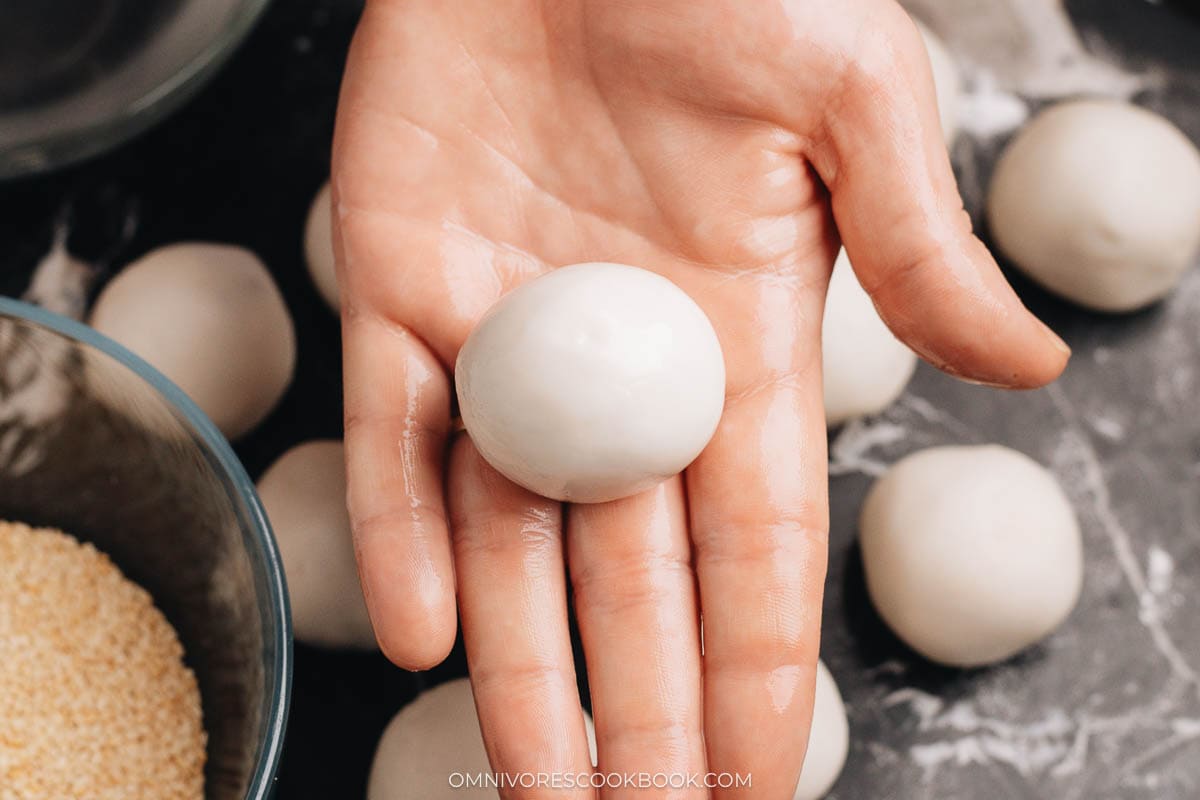
Then place the wet dough ball into the bowl with the sesame seeds. I like to grab the bowl and shake it in a circular motion, so the dough ball rolls in the sesame seeds to coat the surface.
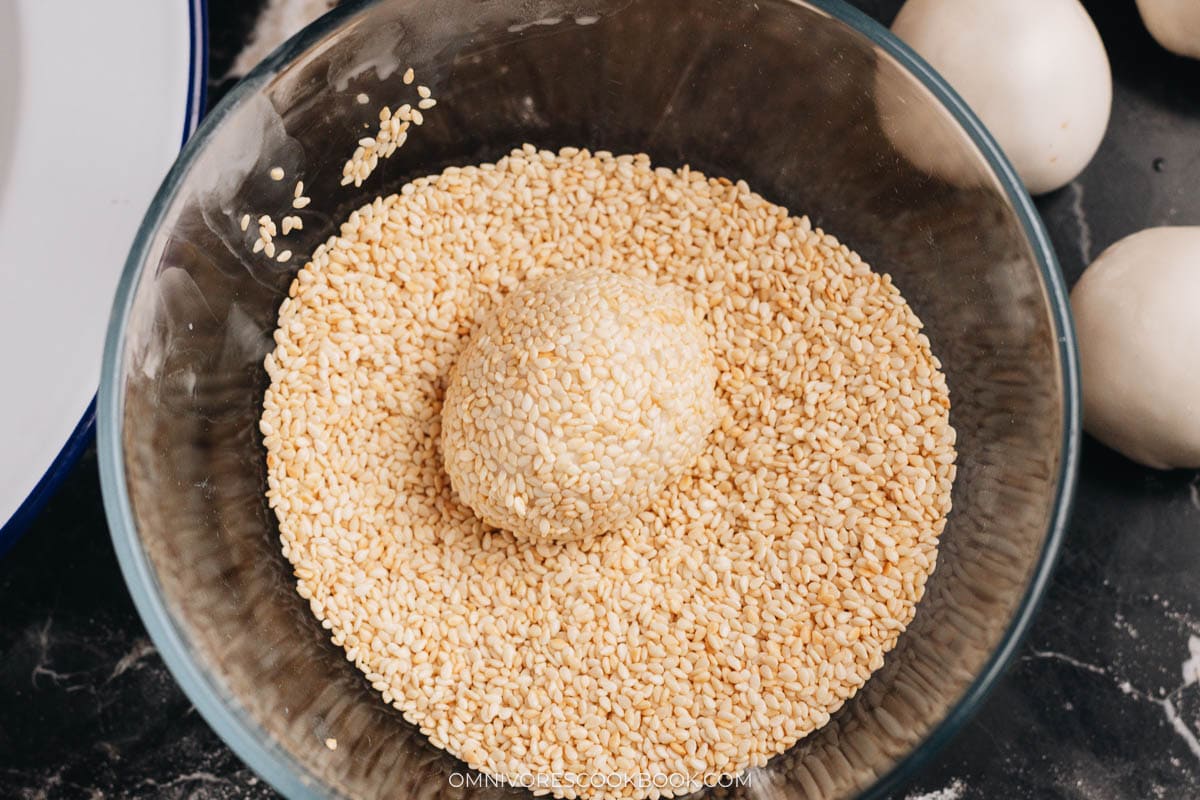
Deep frying the sesame balls
Deep frying the sesame balls requires a quite low temperature, around 290°F (143°C). If the oil temperature is too high, the sugar in the dough will quickly caramelize, which risks cracking the dough and burning its surface.
The sesame balls will sink to the bottom of the pot when you add them. Make sure to gently stir them so they don’t stick onto the bottom.
After a few minutes, they will start to expand and float to the top. You should use a slotted spoon to push the sesame balls down to ensure even browning.
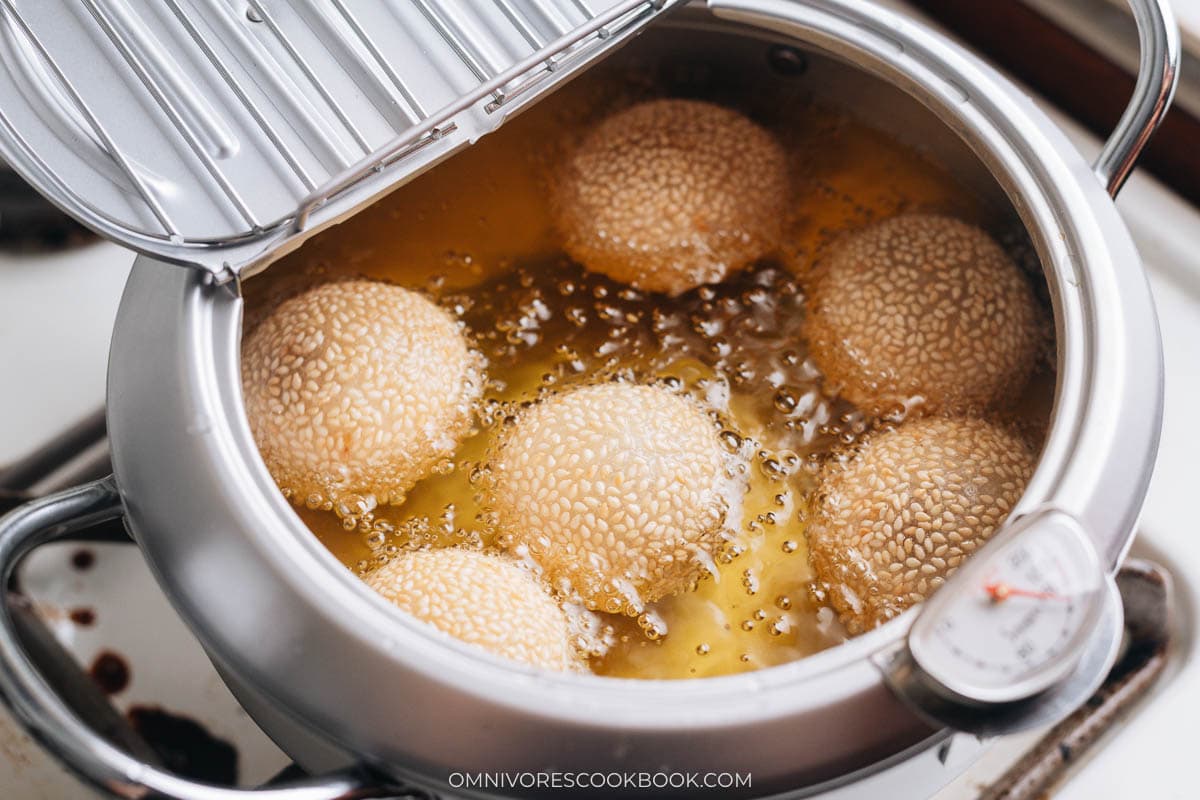
Once the surface turns light golden, the sesame balls are ready. Now you can transfer them to a wire rack lined baking sheet to drain off the excess oil and allow them to cool.
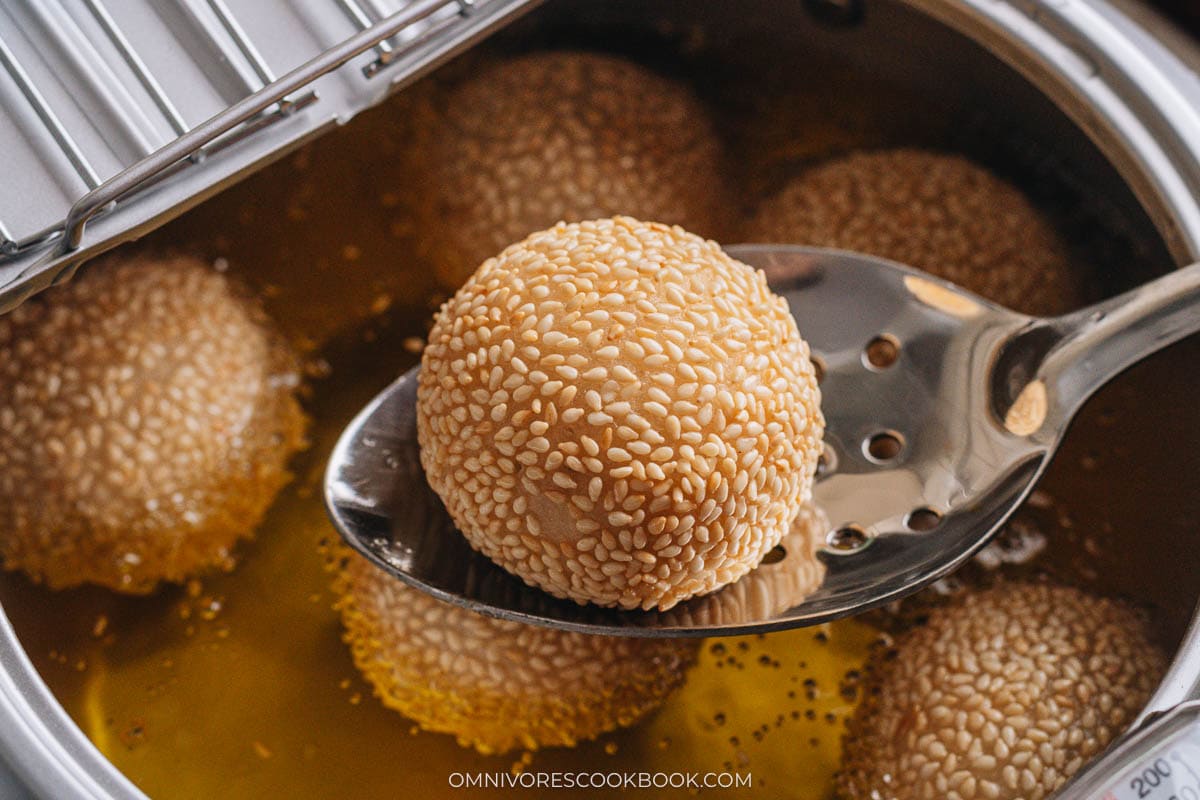
How to store and reheat sesame balls
The sesame balls hold up very well at room temperature and in the fridge. The key is to seal them in an airtight container once fully cooled, so they won’t get soggy by absorbing moisture from the air.
If you plan to serve the sesame balls within 1 to 2 hours, storing them on a plate at room temperature is totally fine. They will stay crispy after they have cooled off.
For longer storage, store in the fridge for up to 1 week, or in the freezer for 3 months. You can reheat them in a 400°F (200°C) oven until heated through and turning crispy again.
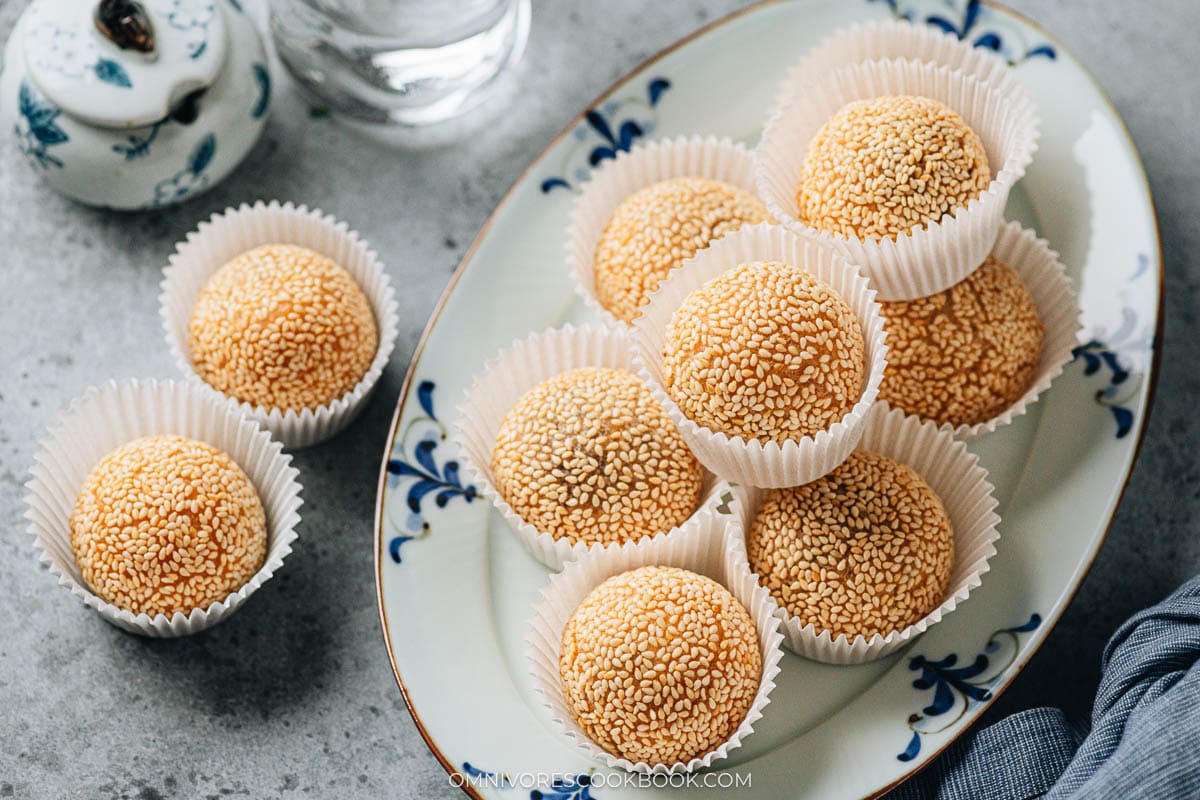
How to serve sesame balls
You can serve sesame balls when they are warm or at room temperature as a dim sum course or a dessert after the meal. It’s a very common dessert / snack to cook for Chinese New Year in the southern part of China.
To serve them the way dim sum restaurants do, you can use a pair of scissors to cut open the sesame balls when they are freshly made and still quite hot. It reveals the gooey texture of the dough and the filling, and looks very cool!
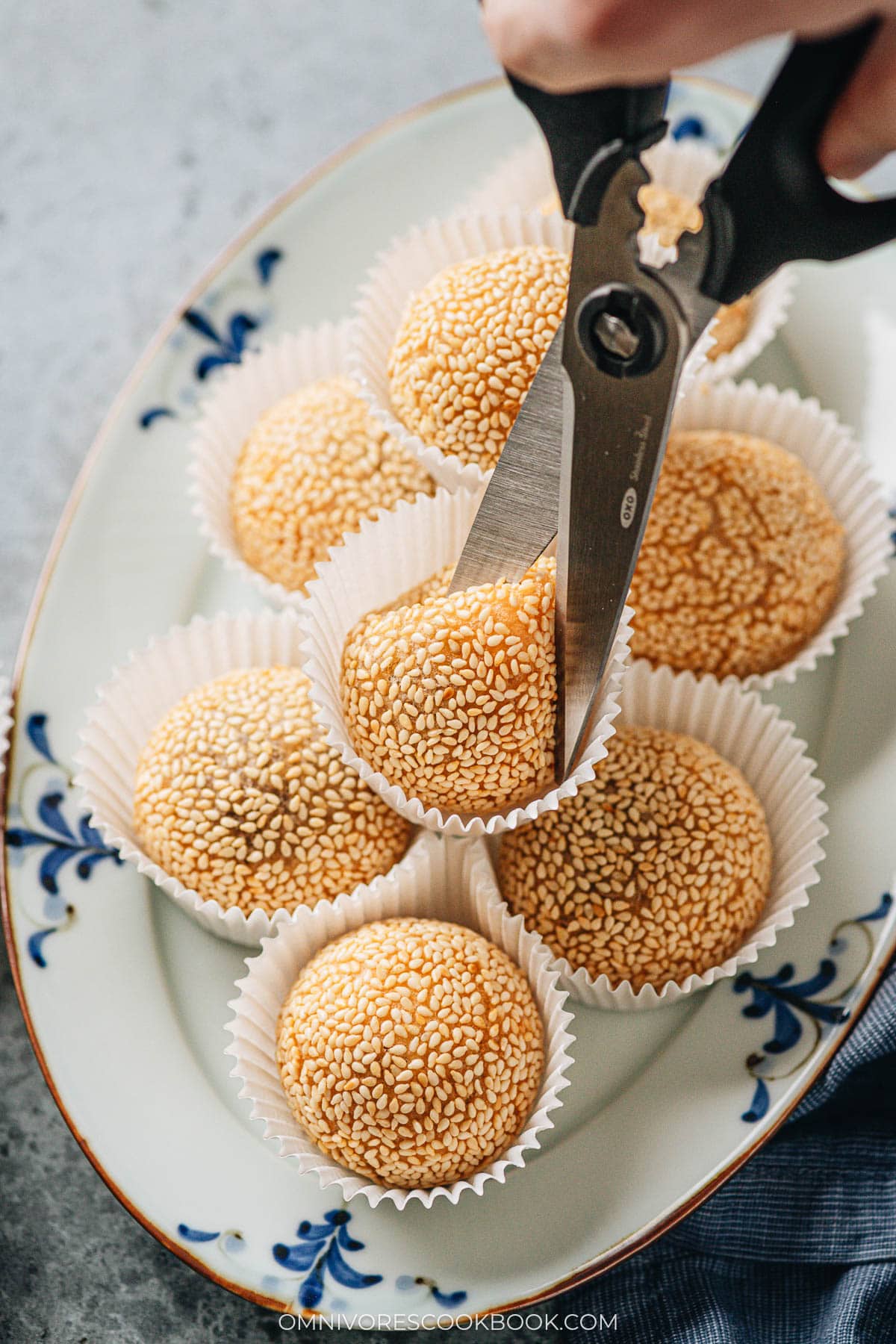
Other dim sum dishes for your party
- Cantonese Chicken Egg Roll (广式鸡肉春卷)
- Cantonese Shumai with Pork and Shrimp (烧麦, Shao Mai)
- Air Fryer Char Siu Pork (空气炸锅叉烧肉)
- Choy Sum with Garlic Sauce (白灼菜心)
- Braised Chicken Feet (凤爪)
- Easy Chinese Steamed Chicken
Chinese Cooking Made Easy
Are you new to this website? This free email series is a great place to start. I’ll walk you through a few of my most popular recipes and show you how and why they work. You’ll quickly start to cook better Chinese food in your own kitchen.
Watch video
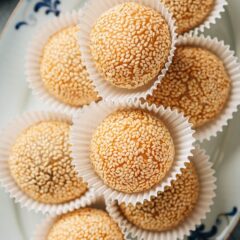
Sesame Balls
Ingredients
- 1 1/2 cup glutinous rice flour
- 3/4 cup water
- 1/2 cup sugar
- 1/2 teaspoon salt
- Vegetable oil , for deep frying (about 8 cups)
- 12 heaping teaspoons red bean paste (or lotus seed paste) (*Footnote 1)
- 1/3 cup sesame seeds (raw, or toasted and hulled) (*Footnote 2)
Instructions
Prepare the dough
- Weigh 140g of glutinous rice flour in a heatproof bowl, and weigh the other 50g in a separate small bowl.
- Add the water, sugar and salt to a small saucepan and bring to a simmer. Stir until the sugar is fully dissolved to make a syrup.
- Slowly add the syrup gradually to the heatproof bowl with the glutinous rice, while mixing with a spatula, until the mixture becomes a smooth paste without any clumps.
- Gradually add the remaining 50g (1/4 cup) glutinous rice flour in three parts, stirring until a cohesive dough is formed. If the dough continues sticking to the bowl, add an additional 10g (about 1 tablespoon) of glutinous rice flour. If it becomes crumbly, add 10g (2 teaspoons) of water.
- Add 1 teaspoon of oil to the dough. Knead it with your hands to incorporate. The dough should become uniform and ductile, and should not stick to the bowl.
- Once the dough is completed, wrap it in plastic wrap and rest in the fridge for 30 minutes.
Prepare the filling
- While the dough rests, weigh out the red bean paste into twelve 16g balls (approximately 1 heaping teaspoon) (*Footnote 3). After weighing, roll each red bean paste portion into a ball by rolling between the palms of your hands. Place the red bean paste balls on a tray, and put it in the freezer (this makes the wrapping much easier and mess-free).
Assemble the sesame balls
- Once the dough has finished resting, transfer it to a clean working surface lightly dusted with glutinous rice flour. Roll the dough into a uniform tube. Cut the dough into 12 equal pieces that weigh approximately 32g each.
- Roll each dough section into a ball with the palms of your hands, and cover with a moistened towel to prevent it from drying out.
- To form the sesame balls, gently flatten a dough ball, forming a dimple in the middle. Place a chilled Red Bean Paste ball inside the dimple. Gently hold the dough ball in your dominant hand, delicately tuck the Red Bean Paste into the dough, while cupping the edge of the dough with your other hand. Continue tucking and cupping the edge of the dough, turning the dough section as you go, until the dough covers the chilled red bean paste ball. Press the edges of the dough together to completely seal the ball (*Footnote 4). Then roll the ball gently in your palms to round it out. Repeat this process with the remaining dough balls. Cover the formed balls with a wet towel to prevent them from drying out.
- Place the sesame seeds in a small bowl. Wet both of your hands. Roll each ball to moisten the exterior, then place it into the bowl with sesame seeds. Gently shake the bowl in a circular motion to coat the ball evenly with sesame seeds. Place the sesame ball onto a tray. Repeat with the rest of the balls.
Cook the sesame balls
- Prepare a sheet pan lined with a wire rack. Heat the oil to 300°F (150°C) in a medium-sized pot, and place half the sesame balls into the hot oil. To prevent the bottoms of the sesame balls from sticking to the pot and burning, gently stir them with a ladle or slotted spoon.
- Continue frying the balls for 15 minutes, while maintaining the oil temperature at 275°F (135°C) to 290°F (143°C). If the oil exceeds 300°F (150°C), turn off the heat and let the oil temperature come back down.(*Footnote 5)
- The sesame balls should begin to float to the top and puff up after the first few minutes. Stir them occasionally to ensure that the balls become evenly crispy.
- After 15 minutes the balls should be a light golden brown, and the sesame seeds should be only lightly toasted. If the sesame balls look pale, slightly raise the temperature to 320-330°F (160-165°C) and continue frying for a few minutes, until the sesame balls turn light golden brown (*Footnote 6). Once the ideal color has been achieved, remove the balls from the oil, and allow them to cool on the sheet pan lined with a wire rack. Repeat the frying process with the second batch of balls.
- Let the sesame balls cool off for 10 to 15 minutes before serving. Serve them warm or at room temperature.
Notes
- Fine red bean paste is easier to shape, but the chunky kind works too.
- Use untoasted sesame seeds, because toasted seeds will further darken after frying.
- It is important to weigh out double the amount of glutinous rice dough to red bean paste. Without enough dough it will not be possible to properly seal the dough.
- Ensure the dough balls are completely sealed, or else they will not puff up, and instead will fill up with oil.
- It is important to keep the oil temperature under 300F. If it rises above this temperature, the sugar in the dough will quickly caramelize, which risks cracking the dough and burning its surface.
- Fry the balls only until they reach a light golden brown, as their cooking will continue as they cool down. The seeds should not darken significantly.
- Store and reheat: Store in an air tight container in the fridge for up to 1 week, or in the freezer for 3 months. Reheat them in a 400°F (200°C) oven until heated through and turning crispy again.
Nutrition

Did you make this recipe?
I’d love to hear how it turned out for you! Please take a moment to leave a 5-star rating ⭐️ and share your thoughts in the comments further down the page. It really helps others discover the recipe too.

CM
This is one of the best recipes I’ve ever made. I only had mochiko flour and added about 1/4 cup to get the texture right but the dough was just the right sweet after the addition. the sesame balls turned out so well on the first try my husband asked if I’d gotten them from the store! they were great fresh but the next day I liked them even better as they had kind of a chew to them. thanks especially for the notes on the frying time and temperature, it never would have turned out as well if I was just eyeballing it but I did pull them out just a touch early, 11-13 minutes. it’s hard holding the oil temp for that long but it was well worth the effort. I made these for lunar new year and the kids loved them and left a trail of sesame seeds wherever they went.
Maggie Zhu
So happy to hear you like the recipe and thanks for the thorough review! I think mochiko is short grain (the Thai brand I used is made from either medium or long grain glutinous rice), that’s why it absorb water different. It’s great that you figure out the dough texture with a different flour. So nice to hear that your kids enjoyed them too 🙂
Curry Cook
Delicious! I made this with a chocolate ganache filling (I love red bean paste, but my kids don’t… yet). With an electric stove, I had a hard time reaching the temperature and was under 290 most of the time. Even so, I found 15 minutes to be too long – they weren’t too dark, but they were too hard. Cooking for about 12 minutes was better. Looking at recipes on other sites, people had issues with sesame balls exploding (in hot oil!) when fried at higher temps, so I really appreciated that this recipe uses a lower temp. Lastly, I think there’s a typo in the instructions. It’s 1.5 cups of flour in the ingredients and 3/4+1/4 in the instructions. I used the former and it worked well.
Maggie Zhu
Thanks so much for leaving a thorough review and sharing your cooking experience! And many thanks for pointing out the typo. I have edited it (no cups measure, just grams). I found the frying time a little hard to judge and it slightly different for everyone’s stove. For me, there were times that took me longer than 15 minutes, but eventually I found 15 minutes was a sweet spot. A lower temperature is actually OK (if not lower than 275F). I will specify that in the recipe now. Anyhow, so happy to hear the recipe worked out for you 🙂